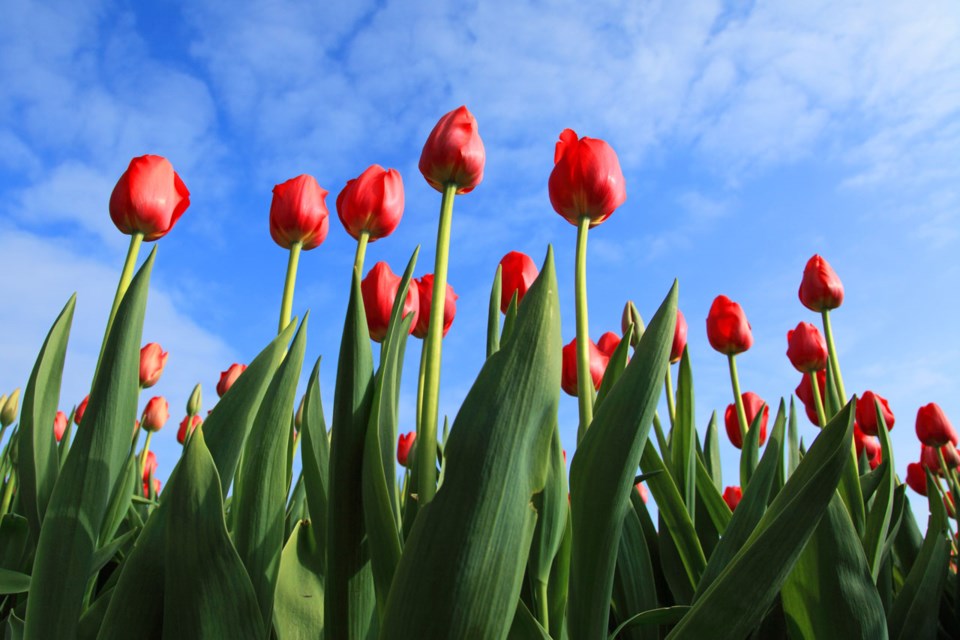Sad to say, but autumn is upon us. But the gardening season is not yet over. Besides raking leaves, harvesting the last of your vegetables, and cutting back perennials, it’s time to start planning for spring by planting bulbs. It’s truly an act of faith when you can put a bulb in the ground in the fall, watch the leaves on the trees fall, followed by cold and snow and then expect flowers to develop in the spring from seemingly nothing.
There are hundreds of different species and cultivars of bulbs and bulb-like plants available to Prairie gardeners. More than just boring red or yellow, there are tulips with fringed edges, with splashes of green, doubles, multi-coloured, striped, tall, dwarf, early spring, late spring and more. Beyond tulips, there are lilies, ornamental onions (Alliums), squills, striped squills, grape hyacinths, snowdrops, some fritillary species (but not crown imperial fritillary), iris and more. Sadly, crocus, narcissus, and daffodils are not reliably hardy and hyacinths and paperwhites are not – however they all can be ‘forced’ for a late winter indoor display.
Size matters. Bulbs – particularly tulips, daffodils and lilies – are graded and priced according to size so expect to pay more for premium-sized bulbs. Purchase the largest specimens that you can afford. Larger bulbs mean more vigorous plants with larger flowers. Avoid damaged, mouldy, or soft bulbs – the price might be attractive but the results will be unsatisfactory.
Plant your bulbs as soon as you buy them. Choose a sunny, weed-free, and well-drained location. Planting depth matters: regardless of species or cultivar, bulbs should be planted at least three times deeper than they are tall. For example, if the bulb is 5 cm (2 inches) tall, make the hole about 15 cm (6 inches) deep. Plant slightly deeper in sandy soil. Initially, dig the hole 5 to 10 cm (2-3 inches) deeper than required. Add some bonemeal, bloodmeal or 11-52-0 fertilizer to the loosened soil and put some of the soil back to make it the proper depth. Place the bulbs, pointy end up, in the bottom of the hole. Cover with the remaining amended soil. Snow cover is important to reduce the damaging effects of winter. To insure against late or poor snow cover, cover with an additional 15 to 20 cm (3-4 inch) layer of organic mulch.
Plant bulbs in clumps of five or more for a natural effect and to increase the visual impact of a massed planting. You can also plant mixtures such as tulips together with ornamental onions or lilies, extending the blooming period of your patch and to add interest. Plant the largest bulbs at their proper depth, cover with soil and plant the next largest at a shallower level (e.g., plant lilies at 25 cm (10 inches) and tulips at 15 cm (6 inches)).
Small species and cultivars (squill, grape hyacinth, snake’s head fritillary, and Tulipa tarda) should be planted near the edge of your border or near a path where they can be seen. Larger species such as tulips, lilies, and ornamental onions can be planted further back to be admired from a distance. Some small species like Scilla or Tulipa tarda can be planted under low-growing junipers. The juniper gives them extra protection over the winter. After the bulbs die down and go dormant in late spring, the ground isn’t bare, so you don’t have to worry about disturbing them during the summer by planting something else to fill the space.
One version of a Chinese proverb is: “When you have only two pennies left in the world, buy a loaf of bread with one, and a lily with the other.” I say throw caution to the wind and spend both pennies on lilies. Besides, you can always eat cake.
Erl gardens in Saskatoon.
This column is provided courtesy of the Saskatchewan Perennial Society (SPS; [email protected]). Check our website (www.saskperennial.ca) or Facebook page (www.facebook.com/saskperennial) for a list of upcoming gardening events.




